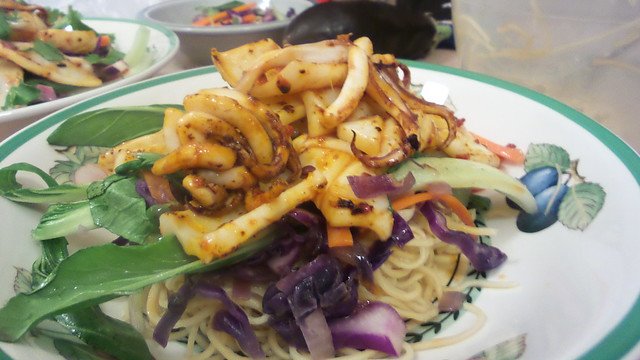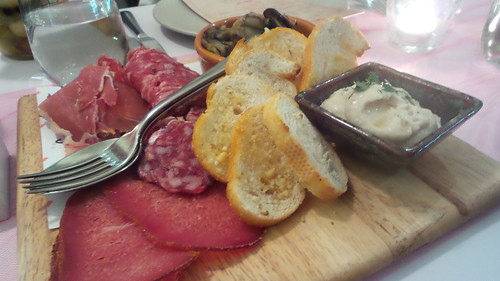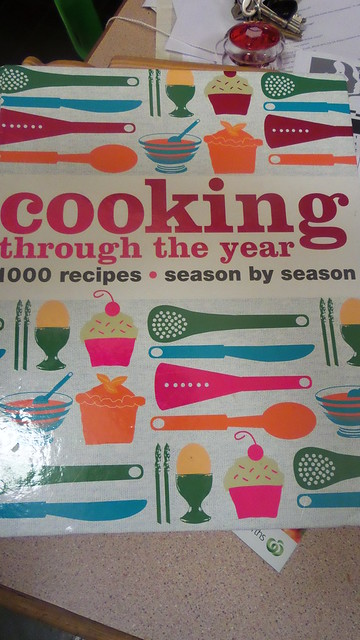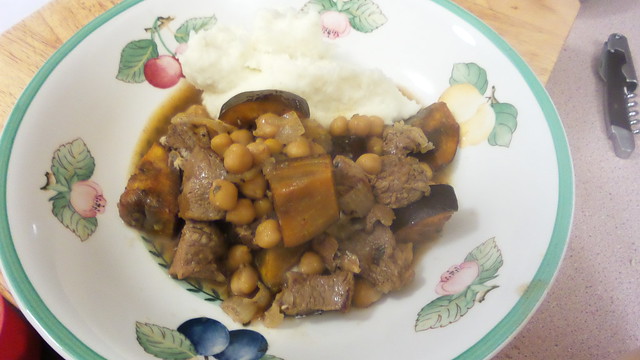When we go to the library (sometimes we get into a routine of going once a week, sometimes it’s more sporadic) the small child chooses his books and toys extremely quickly. Books in particular. Super quick. No browsing here.
But that means there’s no tolerance for my own browsing and so I end up letting him choose a cookbook. So it was that we ended up coming up with the AWW Barbecues & Grills when the weather at the time was far from suggestive of barbecues.
Obviously, a grill or a griddle pan does a perfect approximation of a bbq for indoor purposes but I think it’s also true that you feel a bit less like summery grilled foods with salads in the middle of winter. This made choosing a dish from this out of season book somewhat tricky … but I settled finally on an easy grilled squid dish. In the book it is served with an apple and celery coleslaw but we choose noodles with stir fried Asian greens.
Like many of the dishes in the book (and, perhaps, like many of the best BBQ dishes) this is extremely simple. I bought whole squid which we then had to clean and chop but it would work perfectly with squid rings. And if cephalopods aren’t your thing then the marinade would work well with barbecued or grilled chicken, pork or even some meatier fish.
This cook book is actually one I would seek out to add to my collection. From a design point of view, the recipes are laid out with plenty of space, there are beautiful pictures and the recipes themselves are easy to follow with step by step instructions. Yes, some things are a little basic if you spend any time in the kitchen – Cajun chicken burgers, for example, is basically a case of take chicken breast and rub with Cajun seasoning – but the recipes are a good spread from the very basic and quick through to more novel and labour intensive ideas. And quite a few of the accompaniments or side dishes do put a new twist on things. While this book won’t turn you into a Michelin starred chef, it will enable everyone to put something tasty and quick on the barbecue and give you few new ideas as a bonus.
Ingredients
- squid hoods (or rings, or perhaps sliced chicken or pork) enough for two
- 1 tsp sesame oil
- 1 generous tsp grated ginger
- sambal oelek to taste (anywhere up to and beyond 2 tsp!)
Instructions
- Create the marinade by mixing the sesame oil, grated ginger and sambal oelek.
- Prep your meat - if using the squid hoods, score them and chop into generous bite size pieces. Slice finely pork or chicken.
- Combine the meat with the marinade and set aside for a little. This is not a dish which needs a long marinade.
- Heat your cooking surface to a good high temperature. Cook the squid until just opaque - you will most likely need to do this in small batches and use tongs to turn the pieces. Don't overcook the squid!
- Serve immediately as a starter with an apple and celery coleslaw (that's the book's suggestion) or with stir fried Asian greens and noodles.





